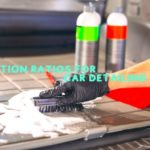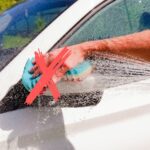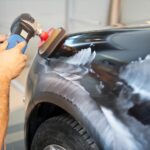
A lot of people are leery about waxing their cars because it’s messy and time-consuming. This is especially true if you’re not a deft car washer. Fortunately, a device called an electric buffer can help solve this problem. So how to wax a car with electric buffer?
To understand this how-to guide, you should familiarize yourself with car wax and electric buffer. Bear with me here so that we can master our polishing skills.
Table of Contents
Understanding Car Wax
Car waxing is an important part of car maintenance that helps protect and enhance the appearance of your vehicle’s paint. If you’re a beginner looking to get started with car waxing, there are a few key things to consider.
One of the first decisions you’ll need to make is selecting the type of car wax that best suits your needs.
Types of Car Wax
There are different types of car wax available on the market. One common type is paste wax, which is solid and requires a manual application. It provides a durable and long-lasting protective layer.
On the other hand, liquid wax is easier to apply and remove than paste wax. It works well for regular maintenance and offers decent protection. Spray wax is a convenient option that allows for quick and easy application, making it ideal for touch-ups and maintaining a glossy finish.
So, with the aid of a buffer, we’d better opt for a paste wax.
What Car Wax Is Right
Choosing the suitable wax for your car depends on several factors. Firstly, consider the age and condition of your car’s paint. If your car has older or faded paint, you may want to opt for a wax that includes polishing agents to help restore the shine.
Also, consider the climate and weather conditions in your area. If you live in a region with extreme temperatures or frequent exposure to sunlight, you may want to choose a wax with UV protection to prevent sun damage.
Synthetic Wax vs Natural Wax
When deciding between synthetic wax and natural wax, it’s important to understand the differences. Synthetic waxes are made from polymers and other chemical compounds. They are typically easier to apply and remove compared to natural waxes.
Synthetic waxes offer good durability and protection against UV rays and environmental contaminants. They are often preferred for their longevity and resistance to harsh weather conditions.
On the other hand, natural waxes, such as carnauba wax, are derived from natural sources. They are known for their rich and deep shine. Natural waxes provide a warm glow to the car’s paint and offer a certain level of depth and clarity. While they may not last as long as synthetic waxes, they provide a more natural and visually appealing finish.
Ultimately, the choice between synthetic and natural wax depends on your preferences and priorities. Synthetic wax may be the better option if you value longevity and ease of use. However, if you prefer a more natural and visually striking finish, carnauba wax or other natural waxes may be the right choice for you.
How to Select The Right Electric Buffer
If you want to know how much an electric buffer on Amazon is, click this link.

Selecting the right electric buffer is crucial when waxing your car effectively.
Types of Buffers
Different types of electric buffers are available, each with its advantages and considerations.
The first type is the rotary buffer, which spins in a circular motion and is ideal for heavy-duty tasks. It provides powerful cutting and polishing capabilities but requires more control skills.
Another popular type is the dual-action (DA) buffer, also known as an orbital buffer. These buffers have a circular pad that oscillates and rotates simultaneously, making them versatile and user-friendly. DA buffers are suitable for beginners and professionals due to their ease of use and ability to deliver satisfactory results.
The random orbital buffer is a great choice for those looking for a buffer that combines power and safety. It moves in a circular motion while also vibrating in random patterns, resulting in swirl-free finishes. Random orbital buffers are less likely to cause damage to the car’s paint, making them a preferred option for many users.
What Makes a Great Electric Buffer
- Suitable with your skill
- Variable speed settings to suit different tasks
- Ergonomic design to enhance your comfort
- Stable power
- Pad sizes
When selecting an electric buffer, there are several factors to consider. Your skill level plays a significant role, as beginners may find DA or random orbital buffers easier to handle, while experienced users may prefer the control offered by rotary or forced rotation buffers.
Besides, consider the purpose of the buffer and whether it will be primarily used for car waxing. In that case, opt for a buffer with appropriate speed settings and a gentle touch to ensure optimal wax application.
Variable speed settings are an essential feature to look for in an electric buffer. Being able to adjust the speed allows you to customize the performance based on the task at hand and the type of surface you’re working on.
Ergonomics is another consideration, as a buffer with a lightweight design, ergonomic handles, and vibration reduction technology will enhance your comfort and ease of use during the waxing process.
The power source is another aspect to think about. Corded buffers provide continuous power, ensuring uninterrupted performance. On the other hand, cordless buffers offer greater portability but may have limited battery life, so consider your preferences and requirements. Lastly, determine your budget range and find an electric buffer that balances quality and affordability.
For car waxing, there are several recommended electric buffer brands to consider. You can check out this article for detail: The Ultimate Guide to Finding the Best Polisher for Cars
The size of the buffer pad is also important, as it determines the coverage area and efficiency of the wax application. Choose a pad size that suits the size of your car and the level of control you desire.
The orbit diameter of DA and random orbital buffers affects the buffer’s aggressiveness. Larger orbits cover more areas but may require additional skill to handle effectively.
Pay attention to the backing plate, as a high-quality one securely holds the pad and ensures stability during use. Additional features such as variable speed control, digital displays, ergonomic design, and noise reduction can further enhance your experience with the electric buffer.
How to Wax a Car With Electric Buffer
Materials You Need
- Electric buffer
- Microfiber towels
- Car wax
- Wash bucket and water
- Bucket of clean water and car soap
- Old rags or paper towels
Preparation
Before waxing your car with an electric buffer, you need to ensure the car is clean. Clean it in sections, using a different towel for each section (like the roof, hood, and each fender).
Make sure to wash the entire car with soap and water before waxing. After drying the car completely, apply pesticides and waxes to it.
For a long-lasting effect, you should go for a paste or liquid wax containing ceramic or silicone for durability. After that, you can wax the car with an electric buffer.
Applying Wax with an Electric Buffer

#1 Using the Right Amount of Wax
To begin, using the appropriate amount of wax on the electric buffer is crucial. Applying too little wax may result in uneven coverage while using an excessive amount can lead to wastage and difficulties in buffing.
Read the instructions provided by the wax manufacturer to determine the recommended amount for your specific electric buffer.
#2 Applying Wax in a Systematic and Efficient Manner
When applying wax with an electric buffer, it’s essential to work in a systematic and efficient manner.
Divide the car’s surface into sections, such as the hood, roof, doors, and trunk, and focus on one section at a time.
This approach ensures that you cover the entire car evenly and prevents the wax from drying before you can buff it.
#3 Techniques for Achieving Even Coverage with an Electric Buffer
To achieve even coverage, start by applying the wax in straight and overlapping lines. This technique helps ensure that every area receives a consistent amount of wax.
As you work, maintain a steady pace and apply gentle pressure on the buffer to spread the wax evenly across the surface.
Avoid leaving any areas untreated or applying excessive pressure, which can lead to unevenness.
#4 Addressing Corners, Edges, and Hard-to-Reach Areas

These areas require special attention during the waxing process. Use the edge of the pad or a smaller attachment specifically designed for these areas to apply wax.
Take your time and apply the wax carefully to ensure thorough coverage. This step helps prevent these areas from being neglected and ensures a uniform finish.
Buffing the Wax
Allowing the Wax to Cure Properly
After applying the wax, allowing it to cure properly is crucial before moving on to the buffing stage. Check the instructions provided by the wax manufacturer for the recommended curing time. Typically, this ranges from a few minutes to several hours, depending on the type of wax used. The wax forms a protective layer and bonds with the car’s paint during this time.
Understanding the Buffing Process
Buffing refers to the process of removing the excess wax and bringing out the desired shine. Before buffing, ensure the electric buffer is set to an appropriate speed for the wax and car surface type. Familiarize yourself with the controls and safety precautions of your specific electric buffer model.
Techniques for Effective Buffing with an Electric Buffer

Hold the buffer at a slight angle and apply even pressure to achieve effective buffing. Move the buffer in overlapping, circular motions to evenly distribute the wax and create friction for polishing. Keep the buffer moving steadily and avoid lingering in one spot, as this may cause damage to the paint. Adjust the pressure and speed as needed to achieve the desired results.
Achieving a High-Gloss Finish
To achieve a high-gloss finish, continue buffing until the wax residue is completely removed and the surface appears smooth and shiny. Take care not to buff excessively, as this can lead to heat buildup and potential damage. Regularly check your progress by inspecting the surface from different angles to ensure a uniform shine.
Removing Excess Wax
After buffing, it’s important to check for excess wax on the car’s surface. Excess wax may appear as streaks, smudges, or a hazy residue. Inspect the surface under different lighting conditions to identify areas requiring further attention.
Use a clean and soft microfiber cloth or towel to remove excess wax. Gently wipe the surface in a back-and-forth or circular motion, applying gentle pressure.
Make sure to fold the cloth or towel regularly to expose a clean section and prevent spreading the removed wax back onto the surface.
Repeat this process until all traces of excess wax are removed, and the surface appears clean and polished. And this is how to wax a car with electric buffer, voila!
You can check this video for a simplified process!
Cleaning the Electric Buffer after Use
After completing the waxing process, cleaning the electric buffer properly is important. Turn off and unplug the buffer before removing the pad.
Clean the pad using warm water, mild soap, or dedicated pad cleaner. Rinse it thoroughly and allow it to air dry.
Wipe the buffer with a clean cloth to remove any wax or residue.
Properly cleaning and maintaining the electric buffer prolongs its lifespan and ensures optimal performance for future use.
Taking Care of the Car’s Exterior Post-Waxing
Once the waxing process is finished, it’s crucial to take care of the car’s exterior to maintain the waxed surface. Avoid washing the car or exposing it to rain for at least 24 hours to allow the wax to cure and bond with the paint fully.
When washing the car in the future, use a pH-neutral car wash soap and a soft sponge or mitt to avoid damaging the waxed surface.
Read More: Polishing vs Compounding The Differences Explained
Regularly inspect the waxed areas for any signs of wear or contamination and address them promptly to maintain the longevity and appearance of the waxed surface.
Maintaining the Waxed Surface for Long-Lasting Results
Maintaining the waxed surface regularly is important to ensure long-lasting results. Here are some things you should do:
- Apply a fresh coat of wax according to the manufacturer’s instructions periodically or as needed, typically every few months.
- Regularly wash the car to remove dirt, dust, and other contaminants that can degrade the wax.
- Avoid parking the car in direct sunlight for extended periods, as excessive heat can accelerate wax deterioration.
How Often Should I Wax My Car?
You should wax your car once every six months to a year. However, if you’re trying to get your vehicle in better shape, you can also try to regularly wax your auto. Make sure you remove all of the old layers of wax before applying a new layer of protection. You can also use an electric buffer to improve the surface quality and shine of the metal surfaces.
Electric Buffer vs. Hand Buffer
An electric buffer is a lot easier to use, as you don’t have to move it around by hand. It continually brushes paint in a small area by spinning a backing plate and pad in controlled patterns and speeds. You can get a lot of work done in a short time with an electric buffer.
If you don’t want to spend the money on an electric buffer, you can also use a hand-held buffer that runs off of electricity. If you’re looking to save money, this is the best option for you.
If you want a detailed comparison between electric vs hand buffing, check out this video!
Check out: How long does it take to wax a car?
Major Benefits of Using an Electric Buffer
Wax makes your car look shiny and clean at the same time. It’s also easy to apply and remove. If you want to maintain the shiny look of your vehicle for a long time, then you should use wax with an electric buffing machine.
• Provides a smoother look than using a hand buffer.
• Adjustable speed control. You can easily change the speed according to your needs. Depending on how hard you press on the pad, it also lets you get a finer or rougher polishing finish.
• Less risk of damaging the paintwork
Drawbacks of Using an Electric Buffer
• The machine can become quite loud. You should wear ear protectors while using one.
• You need to ensure your car is thoroughly waxed before using an electric buffer, or else you’ll end up stuck in the buffer. This will damage the paintwork and bodywork and leave streaks on your vehicle’s paint job.
You can see the difference in detail between how an electric buffer and a hand-operated buffer work. When you’re using an electric buffing machine, you’ll get only smoother, cleaner results.
Find out: Clay bar lubricant: the best usage?!
Frequently Asked Questions
#1 Is it better to hand wax or use a buffer?
If you don’t have the time or energy to wax your car manually, then you can use a buffer instead. The best way to apply wax is by using an electric buffer because it’s less messy and time-consuming. You can also get a more even coat with an electric buffer compared to the hand method.
Find out: Spray wax vs Paste wax The better one?!
#2 Can buffing damage car paint?
When using an electric buffer, you should make sure that your car is dry. Before the electric process starts, you should also put wax or other protectants on your vehicle’s surface. It’s also advisable to use car soap to remove any dirt and dirt particles from the vehicle before you begin buffing.
#3 Can I use a buffer to wax my car?

Yes, you can use a buffer to wax your car. Using an electric buffer can make the waxing process faster and more efficient compared to hand waxing. The buffer’s oscillating or rotary motion helps spread the wax evenly, allowing for better coverage. It also generates friction, which aids in polishing and enhances the gloss of the car’s surface.
#4 Which is better for a small vehicle? A hand buffer or an electric buffer?
Most people prefer to use a bigger, battery-operated buffer for their cars. You can use an electric buffer for cars that are small to medium-sized. However, you need to be careful when using this machine, as the head can move back and forth too fast and damage your paint job if you’re not careful enough.
#5 Can I wax my car under direct sunlight?
It is generally recommended to avoid waxing your car under direct sunlight. Waxing under direct sunlight can cause the wax to dry too quickly, making it difficult to spread and buff evenly. The heat from the sun can also make the surface of the car hot, which can affect the application and bonding of the wax. Choosing a shaded area or working in a covered space is best to ensure optimal conditions for waxing.
#6 Can I use an electric buffer for other detailing tasks?
Yes, an electric buffer can be used for various detailing tasks besides waxing. It is a versatile tool that can be used for polishing, removing scratches, applying compound or polish, and even buffing out swirl marks. When using an electric buffer for tasks other than waxing, make sure to choose the appropriate attachment or pad and adjust the speed and technique according to the specific task at hand.
#7 How long should I wait before buffing the wax?
Different waxes have different recommended curing times, which are typically mentioned in the manufacturer’s instructions. Generally, it is advisable to wait at least 10-20 minutes for the wax to cure before buffing. However, the recommended waiting time may be longer for some waxes, especially those with special formulas or specific application instructions. It is important to follow the instructions provided by the wax manufacturer to ensure the best results.
#8 Can I use a different type of pad for applying wax?
Yes, depending on your preference and desired result, you can use different pads for applying wax. Foam pads are commonly used for applying wax as they provide a good balance of softness and firmness.
However, specialized waxing pads are also available specifically designed for optimal wax application. These pads are typically made of foam or microfiber material and are designed to distribute the wax evenly and provide better control. Choose a pad that is compatible with your electric buffer and suitable for the wax you use.
#9 What is the best way to remove the dried wax residue?
You can use a microfiber cloth or a dedicated wax residue remover to remove dried wax residue. Gently apply light pressure to wipe the surface in a back-and-forth or circular motion.
If the residue is stubborn or hard to remove, you can dampen the cloth slightly with water or use a detailing spray to aid in the process.
Find Out: Swirl Marks on Car: Causes, Prevention, and Removal
#10 Can I wax a matte car using an electric buffer?
Waxing a car with matte paint using an electric buffer is generally not recommended. Matte paint has a non-reflective, textured finish that is designed to absorb light rather than reflect it. Applying wax to matte paint can alter its appearance, causing it to become glossy or uneven.
Conclusion
You should use a buffer on your car every couple of weeks to maintain the shiny look of your vehicle. You can use an electric brush machine to remove small scratches and swirls from the paint. You can also utilize a hand-held buffer for a deeper clean, as it has two different speed settings for you to choose from.
There are a lot of buffing machines available in the market, but you should choose one that is easy to operate and gives superior results.
Hi everyone, My name is Ollie Barker.
As a seasoned auto expert I have 25 years of experience working in repair and detailing shops. I love to share my tips & tricks to all car lovers, so that’s why I’m here at Automotive Gearz publishing my content, sharing my passion. Also, I’ve been giving my recommendations on which products are the best to have on the market. I always thought it was hard to pick the right part, so hopefully I can make that a bit easier for you.
Hope you enjoy your time on my little blog!







